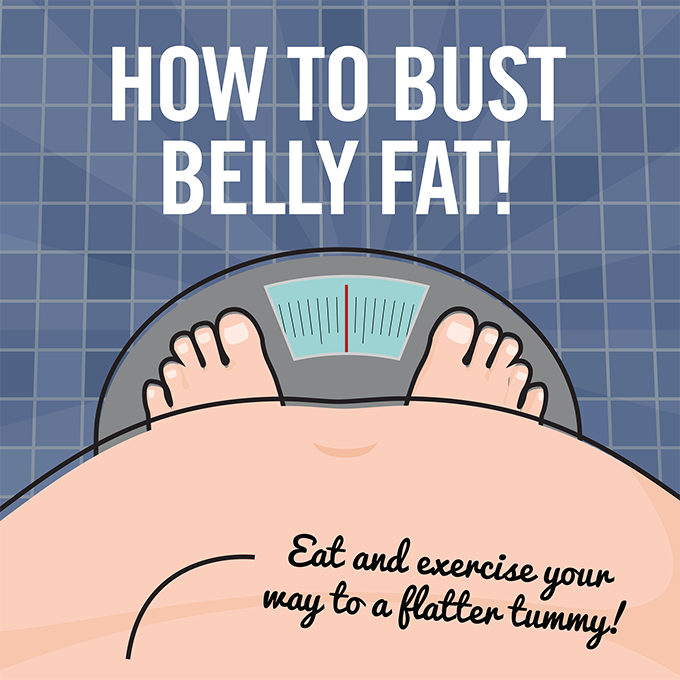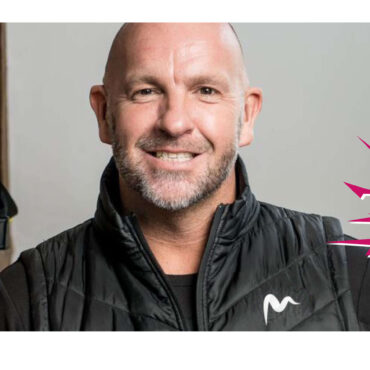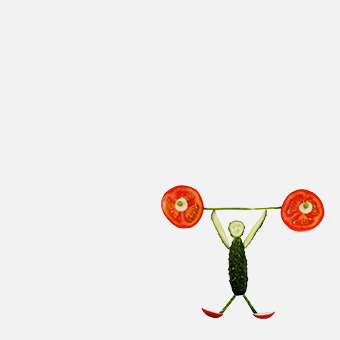Everyone carries weight in different places; you can be the same weight as somebody else when it comes to scales, but yet be a completely different shape and size. There’s one place, however, that is often at the top of the list when it comes to our body dislikes…
Love handles, muffin top, beer belly; we may have affectionate names for the wobbly bits around the middle, but the likelihood is that, if you’re conscious about your body fat, it’s probably the belly fat that you’d most like to get rid of.
It’s also at this time of the year that we become more tummy-aware; in the winter (and if you live in the UK, in the autumn and spring too…) we all cover up, but when it comes to the summer, with trips abroad to sunnier climes or the odd, English flash heat wave, no amount of stomach support panels or vertical stripes will cut it. You’ll end up being poolside, having to strip down. When the clothes come off, the belly often has to come out.
Why it’s dangerous
But there is more than just your “beach body” appearance to be concerned about when it comes to our tummies. Belly fat, or abdominal obesity, as it is medically known, is particularly dangerous for your health, and here’s why. Warning, it’s all about to get a bit sciency.
The fat that sits just below your skin is known as subcutaneous fat. You can tell this fat because it is the type that you can physically pinch or grab with your fingers and hands. The subcutaneous fat sits around your tummy, that’s between your waist and your hips, but the deeper lying fat is known as visceral fat, and it builds up in between and around your stomach and intestines (your viscera). You need some, but too much is not a good thing.
These are, of course, some of your most vital organs, and any fat around them can cause problems to their function. The toxins produced by the visceral fat can increase your risk of heart disease. According to the NHS, extra weight around your middle means you are more likely to develop type 2 diabetes, as well. This is because this type of fat has a different metabolic rate to other types of fat in the body. Therefore, your body becomes less sensitive to insulin.
When your body’s sugar levels rise, the cells will usually kick into action to combat them with insulin, also helping the body to burn energy, but if it is less resistant, it won’t be able to. People with high blood sugar levels are often diagnosed as pre-diabetic, with type 2 diabetes forming within ten years. The havoc caused to the body’s insulin could also cause high blood pressure and cholesterol.
These toxins have also been found to cause inflammation in these areas, and scientists have recently found links between visceral inflammation and various cancers, including colon and pancreatic cancer in particular.
What size waist should I be aiming for?
It can be hard to tell if you are carrying too much belly fat, as the fat around this area can be deceiving. Even if you don’t consider yourself to be overweight, you can be still be carrying this extra dangerous weight which exists mainly below the surface. One guide could be to keep a check on your BMI, or body mass index, which is a measure of your weight against your height. Find a BMI calculator online, and make sure that you are aiming for the healthy section of the scale.
Another way to measure your belly fat is to check your waist size. Don’t do this based on the size of your jeans; get the tape measure out to get the most accurate figure. Line up the tape measure with your belly button, and take the tape around the circumference of your body. No sucking in now! This is important. The NHS website suggests that for men, your waist should be less than 94 cm (or 37 inches), and for women, that should drop to 80 cm (32 inches).
A guide to busting that belly fat!
So now you know why it’s dangerous and what you should be aiming for, it’s time to work out how you’re going to get there. The great news is that there are loads of ways of combating belly fat, from changing your diet and exercise plan, to making adjustments to your lifestyle too. In fact, it has been suggested by some people in the health and fitness industry that belly fat is the easiest type of fat to lose – let’s put that to the test.
Exercising to lessen belly fat
Keep moving
A sedentary lifestyle is the quickest way to increasing visceral fat, so make sure to keep yourself active. This might include strapping a pedometer to yourself, to keep checks on your daily steps, or making sure to take regular breaks whilst sitting at your desk during the day. Get up from your seat, have a shake, wiggle, stretch, or better still, go for a walk. Not only will you reduce the fat build up but your levels of concentration and productivity will be improved too.
For those who are able to be more active, and if we’re honest with ourselves, that’s pretty much all of us, aim for half an hour of exercise every day, whatever that exercise is. The more intense your workout is though, the quicker it will fight the visceral fat.
Packing a punch
Boxing was recently listed by ESPN as the top belly fat burning activity. From warm ups with a skipping rope, to sparring, keeping your core engaged whilst boxing is a sure way to tighten, tone and lose the fat from your middle. Strap on those gloves and get in the ring!
Strength training
There’s an old myth that muscles weigh more than fat, but actually, that isn’t at all accurate. What is true, however, is that muscle burns more calories than fat, so working up your body’s muscles will be very beneficial. Big up the strength training, particularly in the abdominal and core, as well as the areas that surround them like the lower back, thighs and hips. All of these kinds of core stabilisation exercises, such as planks and side planks, sit ups and push ups, can be found in Active Nation’s Legs, Bums and Tums classes – find out more here.
Gym time
Whilst down at the gym, look out for the equipment that will particularly help lessen your belly fat. Time on the treadmill, exercise bikes and rowing machines, will help burn big calories, so make sure to tailor your workout with these.
Slimming sports
If sports are more your thing than time in the gym, look for a sport that keeps you on your toes at all times. Football, netball, hockey and racket sports, not only have you constantly doing bursts of running or jogging, the intense intervals helping you burn some serious calories, but the twisting movements will also help work out your belly.
Catch some zzzs
Did you know that a lack of sleep could also be contributing to abdominal obesity? When we sleep, our body uses up body fat, converting it to fuel. If you aren’t sleeping enough, your body simply doesn’t have the time to do this and the fat will be staying where it is. You should be aiming for around 7-9 hours a night, so make sure to switch off and hit the hay – it’s for your body’s own good.
Stress less
Stress is harmful for us all, but particular links have been found between cortisol, the stress hormone, and increased belly fat. This link may also be due to the tendency to over eat and comfort eat when we are feeling stressed. Try to relax, through meditation or simply having fun with friends, and your abdominal area will thank you in the long run.
Belly fat diet
Eat!
What better news can a dieting foody hear than to be told to eat? Aside from fasting, making sure to eat and not skip meals or starve yourself is important in any diet or healthy eating plan. This goes for a belly fat diet too. When we starve our bodies unnecessarily, we are more likely to become hungry and down-hearted, thinking so much about what to put in our mouths that, when it all becomes too much and the regime goes out the window, replaced instead with overeating and unhealthy foods.
Instead, make sensible, mindful decisions when it comes to meals. Listen to your body, and eat when you’re hungry, and stop when you aren’t anymore. It may sound straight forward, but this method could take some time. Once it’s conquered though, it will bring great benefits to your weight loss and health with it.
The right kinds of fats
We all need a little bit of fat in our diet, but it is important that you are picking ones that will help your body’s health, not hinder it. Although proteins are good, cut off fat to make your meat lean, or seek out low-fat options. Oily fish are not only a good source of protein but high in healthy omega-3 fatty acids too, so keep the salmon and sardines coming!
Look our for monounsaturated fats, which include olive oil, rapeseed oil and avocados. These fight body fats as well as inflammation. Nuts and seeds are also a good choice but, like all of these fats, they are high in calories, so you should be wary of how much, or many, you take in. A good measure could be around twenty almond-sized nuts a day.
When adding in monounsaturated fats, also cut out saturated fats and transfats, which are found in most highly-processed foods. These have very little nutritional value, if any.
Fight fat with fibre
Studies have shown that having the right amount of fibre can help with tummy fat issues, as well as keeping you fuller for longer. This can include fruit like apples, with the skins kept on, and beans and peas are a great option too.
When it comes to bread, look to switch to wholegrain options. These provide you with more fibre, but will also lessen the spikes in your blood sugar, helping with your body’s insulin levels.
Curb your carbohydrates
Your body needs carbohydrates to give it energy. But, just like fats, make sure you’re getting the right type. Complex carbohydrates contain fibre and are anti-inflammatory, so stick to non-starchy vegetables. Simple carbohydrates however are the opposite, and are more likely to cause belly fats. These include white breads, fruit juice, sweets and other junk foods.
It is also suggested that to lose belly fat, you should also avoid refined carbohydrates, including refined grains, and refined sugars. This is when the good, nutritious parts have been stripped away. This may mean you need to swap white pasta, rice and flour for brown, and grains like quinoa and cous cous are also good.
Drink up
When is water not a good idea? It fills you up, keeps you hydrated, improves your energy and metabolism and is good for detoxing too. Make sure to drink 8-10 glasses a day. Green tea has also been suggested as a good for tackling belly fat, so get in a few cups of that too.



















